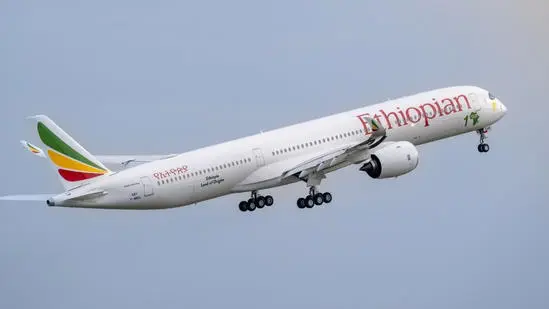
A Mumbai-bound Ethiopian Airlines Boeing 787 Dreamliner made an emergency landing after a mid-air depressurisation incident left seven passengers ill
Panic Over the Arabian Sea: What Happened on Flight ET640
In the early hours of June 27, a routine international flight turned into a high-altitude emergency when Ethiopian Airlines Flight ET640, a Boeing 787 Dreamliner, experienced a cabin depressurisation scare while cruising at 33,000 feet over the Arabian Sea. The aircraft, en route from Addis Ababa to Mumbai, was forced to make an emergency landing at Chhatrapati Shivaji Maharaj International Airport at approximately 1:42 AM.
According to flight tracking data, the aircraft underwent a rapid descent after the cabin pressure dropped, triggering the deployment of oxygen masks and causing panic among passengers. Upon landing, seven individuals reported symptoms of decompression sickness, including dizziness, nausea, and shortness of breath. One passenger required immediate hospitalisation, while the others were treated by airport medical personnel.
The incident has raised serious concerns, especially as it follows a similar episode just days earlier on an Air India flight from London to Mumbai, where multiple passengers and crew members reported feeling unwell mid-air. Aviation authorities are now under pressure to determine whether these are isolated incidents or signs of a broader systemic issue.
A Pattern of Peril: Boeing Under the Spotlight Again
This latest emergency adds to a growing list of safety-related incidents involving Boeing aircraft, particularly the Dreamliner series. While the Boeing 787 is celebrated for its fuel efficiency and long-haul capabilities, it has also faced technical scrutiny over pressurisation systems and structural integrity.
Experts suggest that cabin depressurisation, though rare, can occur due to malfunctioning outflow valves, seal failures, or sensor errors. In such cases, the aircraft must descend rapidly to a breathable altitude typically below 10,000 feet to prevent hypoxia among passengers and crew.
The Directorate General of Civil Aviation (DGCA) has launched an investigation into the incident, with a focus on:
- The aircraft’s maintenance records and pressurisation system logs
- Pilot response protocols and cockpit communication
- Passenger safety briefings and oxygen mask deployment efficiency
- Coordination with Ethiopian Airlines for technical cooperation
This comes amid heightened scrutiny following the tragic Air India AI171 crash in Ahmedabad earlier this month, which claimed over 240 lives. The cumulative effect of these events has prompted the DGCA to initiate surprise safety audits across major Indian airports and international carriers operating in the region.
Turbulence Ahead: What This Means for Flyers and the Aviation Industry
For passengers, the incident is a stark reminder of the fragility of in-flight safety systems. While commercial aviation remains statistically one of the safest modes of travel, the psychological impact of such emergencies can be profound. Several passengers on Flight ET640 reportedly experienced panic attacks, and some required oxygen support even after landing.
The aviation industry, already grappling with post-pandemic recovery and rising operational costs, now faces renewed pressure to rebuild public trust. Key takeaways from this incident include:
- Need for enhanced crew training in handling medical emergencies and passenger distress
- Upgraded cabin monitoring systems to detect early signs of depressurisation
- Transparent communication from airlines regarding safety protocols and incident handling
- Stricter oversight by regulatory bodies on aircraft maintenance and airworthiness
For Boeing, this is yet another reputational blow. The company has faced multiple setbacks in recent years, from the 737 MAX grounding to ongoing quality control concerns. Aviation analysts warn that unless systemic improvements are made, Boeing risks losing its competitive edge in the global market.
The emergency landing of Ethiopian Airlines’ Boeing 787 in Mumbai is more than a technical glitch, it’s a wake-up call for the aviation ecosystem. As investigations unfold, passengers and regulators alike are demanding accountability, transparency, and reform. In an era where air travel is both a necessity and a privilege, ensuring safety at 33,000 feet must remain non-negotiable.
Stay updated with the latest news on Rapido Updates. Keep yourself updated with The World, India News, Entertainment, Market, Automobile, Gadgets, Sports, and many more